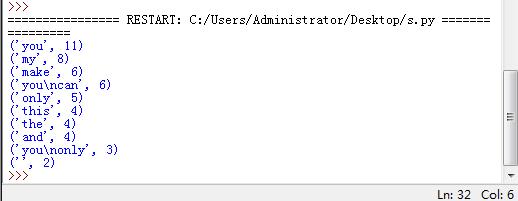组合数据类型练习,英文词频统计实例
Posted 风一样的浪子
tags:
篇首语:本文由小常识网(cha138.com)小编为大家整理,主要介绍了组合数据类型练习,英文词频统计实例相关的知识,希望对你有一定的参考价值。
1.列表实例:由字符串创建一个作业评分列表,做增删改查询统计遍历操作。例如,查询第一个3分的下标,统计1分的同学有多少个,3分的同学有多少个等。
>>> ls=list(\'123456789\') >>> ls [\'1\', \'2\', \'3\', \'4\', \'5\', \'6\', \'7\', \'8\', \'9\'] >>> ls.append (\'10\') >>> ls [\'1\', \'2\', \'3\', \'4\', \'5\', \'6\', \'7\', \'8\', \'9\', \'10\'] >>> ls.pop(0) \'1\' >>> ls [\'2\', \'3\', \'4\', \'5\', \'6\', \'7\', \'8\', \'9\', \'10\'] >>> ls.index (\'3\') 1 >>> ls.count (\'1\') 0 >>> ls.count (\'3\') 1 >>>
2.字典实例:建立学生学号成绩字典,做增删改查遍历操作。
>>> ls={\'文哥\':\'65\',\'文爷\':\'64\',\'文仔\':\'62\'}
>>> ls
{\'文哥\': \'65\', \'文爷\': \'64\', \'文仔\': \'62\'}
>>> ls[\'文兄\']=\'90\'
>>> ls
{\'文哥\': \'65\', \'文爷\': \'64\', \'文仔\': \'62\', \'文兄\': \'90\'}
>>> ls.keys
<built-in method keys of dict object at 0x0000000002F081F8>
>>> ls.keys ()
dict_keys([\'文哥\', \'文爷\', \'文仔\', \'文兄\'])
>>> ls.values ()
dict_values([\'65\', \'64\', \'62\', \'90\'])
>>> ls.items ()
dict_items([(\'文哥\', \'65\'), (\'文爷\', \'64\'), (\'文仔\', \'62\'), (\'文兄\', \'90\')])
>>> ls.get (\'文兄\')
\'90\'
>>> ls.pop(\'文兄\')
\'90\'
>>> ls
{\'文哥\': \'65\', \'文爷\': \'64\', \'文仔\': \'62\'}
3.列表,元组,字典,集合的遍历。总结列表,元组,字典,集合的联系与区别。
>>> ls1=list(\'12345621354\')
>>> ls1
[\'1\', \'2\', \'3\', \'4\', \'5\', \'6\', \'2\', \'1\', \'3\', \'5\', \'4\']
>>> ls2=tuple(\'1197580969\')
>>> ls2
(\'1\', \'1\', \'9\', \'7\', \'5\', \'8\', \'0\', \'9\', \'6\', \'9\')
>>> ls3={\'a\':\'1\',\'b\':\'2\',\'c\':\'3\'}
>>> ls3
{\'a\': \'1\', \'b\': \'2\', \'c\': \'3\'}
>>> ls4=set(\'1235431843\')
>>> ls4
{\'4\', \'2\', \'1\', \'5\', \'8\', \'3\'}
>>> for i in ls1:
print(i,end=\' \')
1 2 3 4 5 6 2 1 3 5 4
>>> for i in ls2:
print(i,end=\' \')
1 1 9 7 5 8 0 9 6 9
>>> for i in ls3:
print(i,ls3[i],end=\' \')
a 1 b 2 c 3
>>> for i in ls4:
print(i,end=\' \')
4 2 1 5 8 3
>>>
列表使用【】,元组使用(),字典使用{},集合使用[()];
列表、字典、集合能增加、修改、删除,而元组不能;
元组创建较简单,只需要在括号中添加元素并使用逗号隔开,列表则相对复杂多。
4.英文词频统计实例
待分析字符串
分解提取单词
大小写 txt.lower()
分隔符\'.,:;?!-_’
计数字典
排序list.sort()
输出TOP(10)
z=\'\'\' Only you
can make all this world seem right
Only you
can make the darkness bright
Only you and you alone
can thrill me like you do
And fill my heart with love for only you
Only you
can make this change in me
For it\'s true
you are my destiny
When you hold my hand
I understand the magic that you do
You\'re my dream come true
My one and only you
Only you
can make all this world seem right
Only you
can make the darkness bright
Only you and you alone
can thrill me like you do
And fill my heart with love for only you
Only you
can make this change in me
For it\'s true
you are my destiny
When you hold my hand
I understand the magic that you do
You\'re my dream come true
My one and only you \'\'\'
for i in ",.":
z=z.replace(i,",")
for i in z:
z=z.lower()
words=z.split(" ")
keys=set(words)
dict={}
for i in keys:
dict[i] = words.count(i)
ls = list(dict.items())
ls.sort(key = lambda x:x[1],reverse=True)
for i in range(10):
print(ls[i])

以上是关于组合数据类型练习,英文词频统计实例的主要内容,如果未能解决你的问题,请参考以下文章